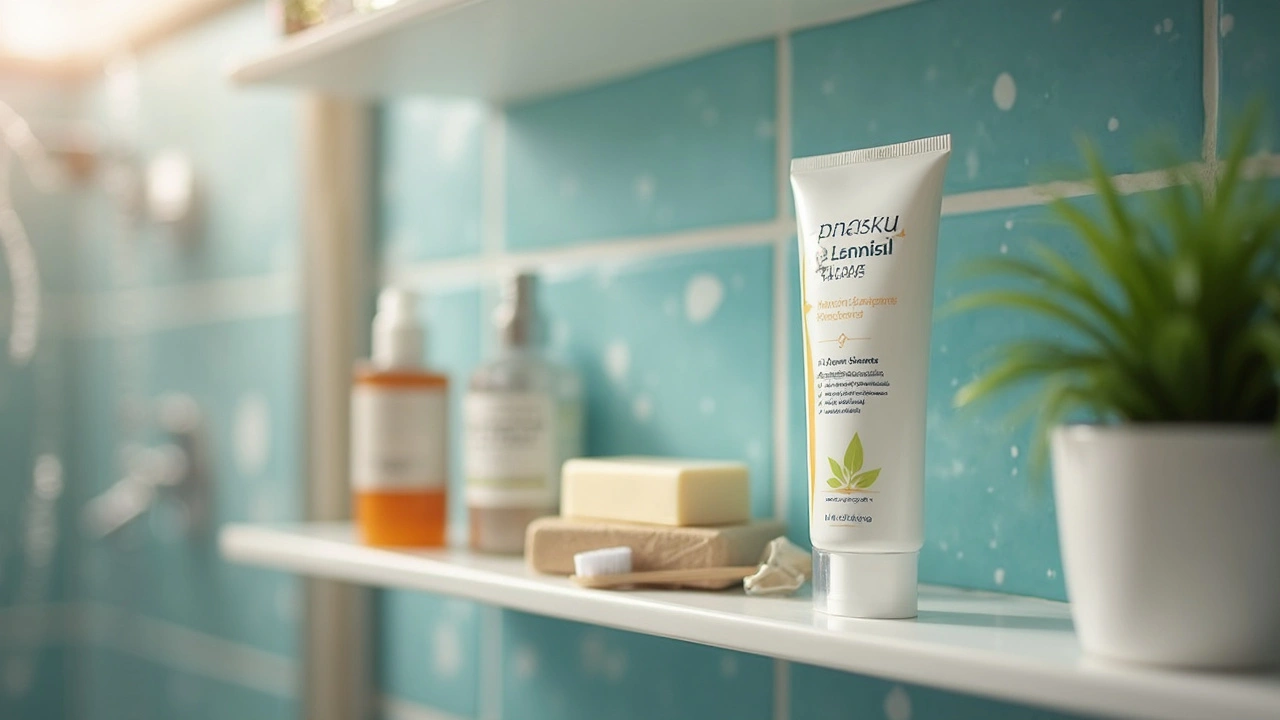Toenails looking weird, itchy skin, strange white spots between your toes—it’s not sexy, but millions of people face these problems. Fungal infections don’t care if you wash daily or douse your feet in powder. They strike anyone, anytime, and can stick around for months if you don’t use the right weapon. There’s a reason you’ll hear “Lamisil” whispered like a secret by people who’ve been through the trenches against fungus.
How Lamisil Works: The Science Behind the Magic
Lamisil, known generically as terbinafine, isn’t just another cream promising to nix toe gunk. Instead, it actually gets inside your body and messes with fungus on a biochemical level. Here’s the deal—fungi build their cell walls with something called ergosterol, kind of like how we have cholesterol. Lamisil jumps in and blocks their ability to make this essential building block. Picture someone cutting off the electricity to a factory; no more production, so the whole system falls apart.
You’ll find Lamisil as a cream, gel, spray, or, the heavy hitter, as tablets. The topical stuff is good for things like athlete’s foot, ringworm, or jock itch. But really stubborn infections, especially nail fungus that’s turned a toenail into a yellow, crumbly eyesore, often need the pill form. This can attack the fungus from the inside out, riding through your bloodstream to reach deep into the root of the infection.
Lab tests prove terbinafine wipes out more than 80% of common fungi after just a few weeks of use. Heat and sweat make fungal infections thrive, but even if you live in flip-flops, Lamisil can take things down hard if you stick with it. That’s why doctors still reach for it when over-the-counter creams can’t even make a dent.
A lot of folks wonder why all antifungals aren’t the same. It’s because different products target different parts of a fungus’s life cycle. Terbinafine goes after that ergosterol pathway, which most dermatophyte fungi (the nasty ones that live on skin) can’t handle. Even newer antifungals can’t top its track record with nailing stubborn nail fungus or skin issues that just won’t quit.
When to Use Lamisil and Who Should Avoid It
You’ve probably seen ads telling you to ask your doctor about Lamisil, but when should you actually bring it up? Start with how long you’ve had the infection and what you’ve already tried. Athlete’s foot that keeps coming back after powder or over-the-counter spray may mean it’s time for something tougher. Nail fungus that’s been turning nails yellow, thick, or brittle for months almost always needs prescription strength—creams rarely work on their own because they don’t soak in deep enough.
Lamisil is especially handy for treating these:
- Athlete’s foot (tinea pedis)
- Jock itch (tinea cruris)
- Ringworm (tinea corporis)
- Nail fungus (onychomycosis)
Now, there are important roadblocks. Not everyone can safely take oral terbinafine. If you have chronic liver problems, uncontrolled lupus, or certain rare genetic disorders, steer clear. The drug is metabolized in the liver, so it can push already struggling organs over the edge. Blood pressure meds, antidepressants, and some antibiotics can interact badly, so your whole medication lineup matters. Always tell your doctor about anything you’re taking, even over-the-counter stuff.
Pregnant or breastfeeding? It’s been around for decades, but there isn’t enough clear data to prove it’s totally safe during pregnancy. Most doctors play it cautious; they’ll only recommend it if the benefits really outweigh the risks. Topical creams are a safer bet here because they stay mostly at the skin level.
And don’t even bother if you’re hoping for a “quick fix.” Nail fungus can take three months or longer for the tablet to do its job, and sometimes nails grow out so slowly that new, healthy nail only shows up after six months. This stuff is for the patient, not the impatient.

Lamisil Side Effects: The Good, the Bad, and the Weird
If you’re popping pills, you need to know what could go wrong. The most common side effect is a tummy that feels off—think mild diarrhea, a bit of nausea, or a strange taste in your mouth. Some people describe it as “metallic,” like you’re sucking on a penny. Pretty annoying, but usually not serious enough to quit treatment.
Rashes and headaches come next on the list. If you get a red, itchy patch or a pounding head that won’t go away, tell your doc. Rarely, your skin can break out in hives, or you could see signs of something scarier like Stevens-Johnson syndrome. Luckily, these dangerous reactions are rare, hitting about one in several thousand users.
Liver trouble is probably the scariest risk. Because the body breaks down terbinafine in the liver, a small number of people get elevated liver enzymes, and a tiny handful can even get hepatitis. That’s why most doctors check your liver enzymes with a blood test before starting you on the full three-month course, and again during treatment. Symptoms to watch for are yellowing eyes, unusual fatigue, dark pee, or pale stools—these could point to real trouble.
Something you might not read on the bottle: changes to your sense of taste or smell can happen. Imagine your morning coffee suddenly tasting flat or nothing at all. These changes are almost always temporary but can take weeks or months to return to normal after stopping the med.
For the topical forms—cream, spray, or gel—the risks stay mostly local. Irritation, redness, dryness, or peeling can show up, but these are usually mild. Because so little of the drug gets into your bloodstream with the topical route, the risk of liver or full-body side effects is close to zero. Good news if you’re just dealing with a patch of ringworm.
Don’t let the list scare you off. Most people breeze through treatment with just minor annoyances. The odds of a serious issue are much low, but it pays to know what to watch for so you don’t brush off a dangerous reaction as “just another weird thing.”
Tips for Getting Real Results with Lamisil
People make two huge mistakes with antifungals: they quit too early, or they use too little. Fungi have thick cell walls and can hide deep under nails or inside skin folds. If you’re not attacking long enough, the infection just hangs out and comes roaring back. It’s not like an antibiotic, where you feel better after three days. For nail fungus, doctors usually prescribe one 250 mg terbinafine tablet every day for three months—sometimes even longer depending how gnarly the nail looks.
Here’s what real success looks like:
- Wash and thoroughly dry your skin or nails before using the cream or spray. Fungi love moisture, so get rid of every drop.
- Apply creams after showers, when the skin's soft but dry. A thin layer is better than a thick glob—too much traps in moisture and messes with the healing.
- With oral terbinafine, stick with it every day, even if you can’t see any changes yet. New nail grows in from the bottom up, so don’t expect overnight miracles.
- Wear breathable socks and shoes. Synthetic fibers trap sweat, which gives fungus a playground. Cotton and wool breathe better and cut the risk of re-infection.
- Disinfect nail tools, clippers, and your shower floor. Fungi hang around long after you think they're gone.
- If you have both nail and skin infections, treat both at once. Fungus on the skin will just hop back to your nails, or vice versa.
- Don’t share towels or shoes while you’re in treatment. Fungal spores are surprisingly good at traveling between people.
Doctors sometimes change course if the infection looks especially stubborn. For example, if the fungus seems resistant or you’ve failed treatment before, they might suggest combining topical and oral therapy. Laser treatments and nail lacquers can help in rare, stubborn cases, but terbinafine taken properly still cures the majority of cases.
Some pharmacists say people forget doses because the nail looks the same for weeks, and then they ditch the meds early. Don’t make that mistake. Stick it out—your nails will thank you, eventually.

Lamisil: Myths, Unexpected Facts, and What’s Next for Antifungal Science
A little myth-busting is in order. First, there’s a rumor that once you get nail fungus, you’re cursed forever. Not true—most people are totally clear after the first long course of terbinafine tablets. Staying fungus-free after that? That’s all about keeping your feet clean, dry, and not sharing sweaty sneakers.
Another myth: all yellow, thick nails mean fungus. Actually, other things like psoriasis, injury, or even tight shoes can look just like onychomycosis. That’s why it’s smart to get a real diagnosis. Some clinics actually do a quick clipping and check it under a microscope—no guessing.
Crazy fact most folks don’t know: you can test for fungus with a special black light, called a Wood’s lamp, in some clinics. Certain types of fungus glow a weird green under that light. Not all types, but the effect is wild to see in person.
And for those who worry about drug resistance? Yes, there are a few strains of fungus that have mutated to dodge terbinafine—doctors first spotted this in India and Europe over the last decade. While these resistant cases are still rare, researchers are testing combinations of meds or totally new classes of antifungals to stay ahead of this curve.
Looking to the future, scientists are working on topical films and medicated patches that push terbinafine deeper into nails or skin without needing pills. Early studies say these might cut down on side effects even more, but for now, the classic cream-or-pill combo remains the big gun.
The bottom line? When it comes to wiping out stubborn fungal infections, especially nail fungus, lamisil is still king. If you stick to your treatment plan, avoid those old shoes, and give your feet a little more air, you’ll have a good shot at smooth, healthy skin and nails. Fungi might be resilient, but with the right approach, you can beat them at their own game.



19 Comments
Eve Perron May 30, 2025 AT 01:00
When confronting onychomycosis, it is essential to recognize the mechanistic pathway by which terbinafine exerts its antifungal activity; the drug inhibits squalene epoxidase, thereby impeding ergosterol synthesis, a cornerstone of fungal cell membrane integrity. This inhibition leads to an accumulation of squalene, which exerts a toxic effect on the fungal cell, ultimately culminating in cell death. The oral formulation achieves systemic distribution, allowing penetration into the nail bed where topical agents cannot reach effectively. Clinical studies indicate eradication rates exceeding eighty percent when adherence is maintained throughout the prescribed three‑month regimen. Moreover, the pharmacokinetic profile demonstrates a half‑life sufficient to sustain therapeutic concentrations in keratinous tissue. Patients should be counseled regarding the necessity of consistent daily dosing, as intermittent intake compromises drug levels and fosters potential resistance.
Monitoring liver function tests prior to initiation, and periodically thereafter, mitigates the risk of hepatotoxicity, a rare but serious adverse event. Adverse effects such as dysgeusia, gastrointestinal upset, or cutaneous reactions are generally self‑limited and do not necessitate discontinuation unless severe. The importance of patient education cannot be overstated; proper foot hygiene, moisture control, and avoidance of shared footwear markedly reduce reinfection rates. In summary, terbinafine remains a first‑line agent for dermatophyte infections due to its targeted mechanism, high efficacy, and favorable safety profile when used judiciously.
Josephine Bonaparte June 1, 2025 AT 08:33
Listen up, if you've been slapping on over‑the‑counter creams and seeing no change, it's time to step up to Lamisil-definately the game‑changer you need! Don't let a little fungus dictate your life; get the prescription and stick to the schedule, no excuses.
Meghan Cardwell June 3, 2025 AT 16:06
From a clinical pharmacology perspective, terbinafine’s high lipophilicity facilitates its accumulation in stratum corneum and nail matrix, rendering it superior to azoles which exhibit lower keratin affinity. The drug’s minimum inhibitory concentration (MIC) against Trichophyton rubrum often falls below 0.01 µg/mL, underscoring its potency. Therapeutic drug monitoring is typically unnecessary due to predictable pharmacodynamics, yet clinicians should remain vigilant for drug‑drug interactions, particularly with CYP2D6 substrates.
stephen henson June 5, 2025 AT 23:40
Just a heads‑up: taking the pills every day is the only way to see real progress. 🌱 Stick with it, and you'll notice healthier nail growth after a few weeks-patience is key!
Manno Colburn June 8, 2025 AT 07:13
Ever wonder why a fungus thrives on our feet like it's on a grand existential stage? It's because we unknowingly provide the perfect moist habitat, and the meds we use, like Lamisil, are the curtains that finally drop on the performance. Yet, many of us stum over the corridore of forgetful pill‑taking, letting the fungal drama continue unpunished. I've seen it alik a never‑ending loop: infection, treatment, stop-then boooom, back again. The reason? Lack of consistency + the nudge from a busy life. So, remember, the pill isn't just a pill; it's a promise to yourself to end the ceaseless saga of toe‑nightmares.
Namrata Thakur June 10, 2025 AT 14:46
Hey there! I know fungal infections can feel super discouraging, but you’ve got this! 🌟 Keep those feet dry, wear breathable socks, and if you decide to try Lamisil, follow the doctor’s directions exactly. Trust me, with a bit of patience and the right care, you’ll see those nails start to look healthy again. Stay positive-your feet will thank you!
Chloe Ingham June 12, 2025 AT 22:20
Can you imagine the shadowy cabal of big‑pharma that wants you to stay in the dark about cheap, natural remedies? They push Lamisil like it’s the only savior while ignoring centuries of folk wisdom. The truth is hidden, and only the vigilant will see through the smear campaigns. So next time you hear “just take the pills,” remember there’s a deeper agenda at play.
Mildred Farfán June 15, 2025 AT 05:53
Oh, absolutely, because nothing says “I’ve got my life together” like a three‑month prescription for toenail fungus. 🙄 But hey, at least you’ll have a great conversation starter at parties: “Did you know my nails are on a medication schedule?”
Danielle Flemming June 17, 2025 AT 13:26
Let’s get real, folks-fighting fungus is a marathon, not a sprint. Keep your feet fresh, toss those damp socks, and stay on the Lamisil train even when you don’t see instant results. You’ll be dancing in your sandals sooner than you think!
Anna Österlund June 19, 2025 AT 21:00
Don’t waste time-just start the pills.
Brian Lancaster-Mayzure June 22, 2025 AT 04:33
In my experience, the best outcomes come from combining proper foot hygiene with the prescribed regimen. I’ve seen patients who diligently wash, dry, and rotate footwear achieve quicker nail regrowth. It’s all about consistency and a supportive environment.
Erynn Rhode June 24, 2025 AT 12:06
First of all, let me say that the information presented here is solid; however, there are a few nuances worth highlighting. For instance, while terbinafine is generally well‑tolerated, patients should be aware of the occasional metallic taste-a side effect that, although benign, can be surprisingly unsettling. 😊 Additionally, proper application of the topical form requires thorough cleaning of the affected area; skipping this step can drastically reduce efficacy. Lastly, don’t underestimate the psychological boost that comes from seeing incremental improvements; it fuels adherence, which is the cornerstone of success.
Rhys Black June 26, 2025 AT 19:40
One must concede that the discourse surrounding antifungal pharmacotherapy is often reduced to simplistic anecdotes, ignoring the intricate biochemical ballet orchestrated by agents such as terbinafine. To truly appreciate its merit, one must engage with the literature, parsing the subtle interplay of enzymatic inhibition and fungal apoptosis-an endeavor not suited for the faint‑hearted. Yet, the masses persist in their cavalier approach, favoring instant gratification over scholarly rigor.
Abhishek A Mishra June 29, 2025 AT 03:13
Hey buddy, Lamisil works well if you follow the doctor’s orders and keep your feet dry. It’s not rocket science, just stick to the plan and you’ll see results.
Jaylynn Bachant July 1, 2025 AT 10:46
Life is like a nail-if you ignore the hidden rot, the whole thing falls apart; so why not give it the right meds and watch it grow back whole?
Anuj Ariyo July 3, 2025 AT 18:20
It is essential, therefore, to maintain awareness; keep feet dry, apply medication correctly, and monitor progress; these steps collectively, lead to successful treatment.
Tom Lane July 6, 2025 AT 01:53
Let’s fire up that motivation! You’ve already taken the first step by learning about Lamisil-now stick to the schedule, stay active, and picture yourself flaunting healthy nails at the beach. You can do it!
Darlene Young July 8, 2025 AT 09:26
I love how Danielle emphasized consistency-seriously, sticking to the regimen and keeping feet dry makes all the difference. Trust the process and watch the fungus bow out.
Steve Kazandjian July 10, 2025 AT 17:00
Nice points, Manno, but let’s keep it simple: take the pills, don’t skip, and check liver tests if you feel off.